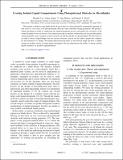| dc.contributor.author | Lee, Hyundo | |
| dc.contributor.author | Gupta, Ankur | |
| dc.contributor.author | Hatton, Trevor Alan | |
| dc.contributor.author | Doyle, Patrick S | |
| dc.date.accessioned | 2017-05-18T15:38:28Z | |
| dc.date.available | 2017-05-18T15:38:28Z | |
| dc.date.issued | 2017-04 | |
| dc.date.submitted | 2017-02 | |
| dc.identifier.issn | 2331-7019 | |
| dc.identifier.uri | http://hdl.handle.net/1721.1/109165 | |
| dc.description.abstract | We propose a method to trap liquid (both oil and water) in a microchannel by sequentially injecting oil and water (or vice versa) over photopatterned obstacles with controlled wetting properties. We present a simple geometrical model to understand the liquid-entrapment process and predict the evolution of the water/oil interface over an obstacle. Our analysis provides an analytic solution that can successfully predict useful properties such as angular position of pinch-off and the amount of captured liquid. We show that we are able to obtain a liquid bridge over two circular obstacles, and we are also able to predict the condition for the formation of a bridge. We further demonstrate the effect of the obstacle shape and how a sudden change in gradient results in larger liquid entrapment. We also demonstrate the ability to entrap isolated liquid chambers for parallel experimentation. | en_US |
| dc.publisher | American Physical Society | en_US |
| dc.relation.isversionof | http://dx.doi.org/10.1103/PhysRevApplied.7.044013 | en_US |
| dc.rights | Article is made available in accordance with the publisher's policy and may be subject to US copyright law. Please refer to the publisher's site for terms of use. | en_US |
| dc.source | American Physical Society | en_US |
| dc.title | Creating Isolated Liquid Compartments Using Photopatterned Obstacles in Microfluidics | en_US |
| dc.type | Article | en_US |
| dc.identifier.citation | Lee, Hyundo; Gupta, Ankur; Hatton, T. Alan and Doyle, Patrick S. "Creating Isolated Liquid Compartments Using Photopatterned Obstacles in Microfluidics." Physical Review Applied 7, no. 044013 (April 2017): 1-13 © 2017 American Physical Society | en_US |
| dc.contributor.department | Massachusetts Institute of Technology. Department of Chemical Engineering | en_US |
| dc.contributor.department | Massachusetts Institute of Technology. Department of Mechanical Engineering | en_US |
| dc.contributor.mitauthor | Lee, Hyundo | |
| dc.contributor.mitauthor | Gupta, Ankur | |
| dc.contributor.mitauthor | Hatton, Trevor Alan | |
| dc.contributor.mitauthor | Doyle, Patrick S | |
| dc.relation.journal | Physical Review Applied | en_US |
| dc.eprint.version | Final published version | en_US |
| dc.type.uri | http://purl.org/eprint/type/JournalArticle | en_US |
| eprint.status | http://purl.org/eprint/status/PeerReviewed | en_US |
| dc.date.updated | 2017-04-19T22:00:07Z | |
| dc.language.rfc3066 | en | |
| dc.rights.holder | American Physical Society | |
| dspace.orderedauthors | Lee, Hyundo; Gupta, Ankur; Hatton, T. Alan; Doyle, Patrick S. | en_US |
| dspace.embargo.terms | N | en_US |
| dc.identifier.orcid | https://orcid.org/0000-0003-3506-5712 | |
| dc.identifier.orcid | https://orcid.org/0000-0002-4558-245X | |
| mit.license | PUBLISHER_POLICY | en_US |
| mit.metadata.status | Complete | |
